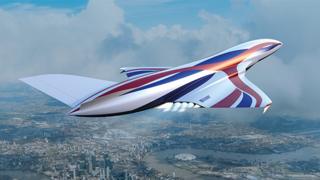UK’s air-breathing rocket engine set for key tests

 Image copyright Reaction Engines LTD
Image copyright Reaction Engines LTD The UK project to develop a hypersonic engine that could take a plane from London to Sydney in about four hours is set for a key demonstration.
The Sabre engine is part jet, part rocket, and relies on a novel pre-cooler heat-exchanger technology.
This pre-cooler system will begin a new phase of testing in the next month or so in Colorado, US.
Meanwhile, the core part of the engine has just gone through its preliminary design review.
Signed off by experts at the European Space Agency, the review sets the stage for this central section of Sabre to begin its own demonstration campaign at Wescott Space Cluster in Buckinghamshire next year.
The company behind the project, Reaction Engines Ltd (REL), says it is making good progress.
Not only would Sabre power units enable rapid, point-to-point transport inside the atmosphere, but they would also allow reusable vehicles to make the jump straight to orbit without the need for multiple propellant stages – as is the case now with conventional rockets.
Sabre would work like an air-breathing jet engine from standstill to about Mach 5.5 (5.5 times the speed of sound) and then transition to a rocket mode at high altitude, going at 25 times the speed of sound to get into space, if this is the chosen destination.
Achieving this flight profile is a challenge in managing temperature extremes.
The essential innovations include a compact pre-cooler heat-exchanger that can take an incoming airstream in the region of 1,000C and cool it to -150C in less than 1/100th of a second.
REL proved the pre-cooler’s efficiency at taking an ambient air stream to low temperature in 2012. Now it must do the same in a very high-temperature regime. This is the purpose of the Colorado tests.
“To have a very high-temperature, high-volume flow of air to test the pre-cooler – we needed a new facility. That is now complete,” explains Shaun Driscoll, REL’s programmes director
“We will be running tests in the next month or two. We will be using re-heated aero engines to drive air through the system. We will drive air into the pre-cooler at up to 1,000C.”
Sabre, at a fundamental level, can be divided into three sections – the pre-cooler front-end; a core combustion section with a smart thermodynamic cycle to again manage heat and fluid flow; and a relatively conventional rocket arrangement at the rear.
It’s the core section that is having a new test facility built for it at the Wescott space park, the site of Britain’s post-war Rocket Propulsion Establishment.
The building is nearing the end of its preparation and the design work on the core of Sabre is also moving towards its conclusion.
“The core can be tested on the ground, but it’s the core that gets you air-breathing from the ground up to the edge of space, at which point there is no more oxygen to breathe and the system transitions to the pure rocket mode,” Mr Driscoll said.
REL is a private venture with the backing of aerospace giants BAe Systems, Rolls-Royce and Boeing. It has also received significant R&D support from the UK government. Esa’s propulsion specialists act as technical auditors, assessing each step in the development of the Sabre concept.
“The positive conclusion of our Preliminary Design Review marks a major milestone in Sabre development,” commented Esa’s Mark Ford.
“It confirms the test version of this revolutionary new class of engine is ready for implementation.”
Jonathan.Amos-INTERNET@bbc.co.uk and follow me on Twitter: @BBCAmos


